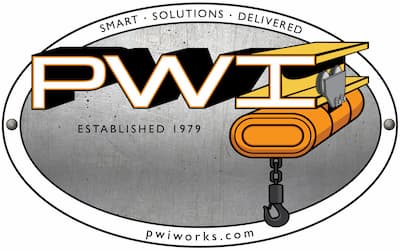B Deck is the preferred method of floor construction for multi-story structural steel framed buildings and mezzanines, but it can also be used in roofing and siding applications. With a high strength-to-weight ratio thanks to its 1.5” depth and a wide rib, plus availability in a variety of gauges and finishes, B Deck is an economical and easy-to-install metal decking solution.
B Decking is the most common structural metal decking in the industry. With a high strength-to-weight ratio thanks to its 1.5” depth and a wide rib, B Deck is able to span short to medium lengths of three to ten feet and provides an economical and easy-to-install metal decking solution for roofing and flooring applications.
Where Is B Decking Used?
While PWI primarily uses B Decking for mezzanine floors, it is commonly used for commercial building flooring, roofing, and sometimes for siding and other architectural purposes.

How is B Deck Made?

B Deck is made using a steel deck roll-forming machine. It feeds metal sheets of the desired gauge from a roll through a series of weighted and carefully positioned rollers that gradually press and form the metal sheet into what we know as B Deck.
The rolling process happens across the very long length of the machine that will usually comprise 25-35 rolling axles, each with a die engineered to create the ribs. The configuration of components can vary to suit different types of metal decking such as embossing or different decking profiles.
What Are Different Options for B Deck?
B Deck is characterized by its specific shape of 1½” deep and 3½” wide ribs, but there are a variety of options in gauge, finishing, and sidelap types.
For example, Form Deck uses the same shape and rib depth as B Deck but it is used only for concrete floor applications.
Thickness (Gauge)
The gauge or thickness of metal decking is an important property of B Deck. Most importantly it will affect the span and load capabilities, and also the diaphragm shear value.
The gauge is also the main factor that determines the price of the B Deck per square foot, with a heavier, thicker gauge being more expensive, and a lighter, thinner gauge being cheaper.
Type B Deck is most commonly available in four sizes:
- 16 gauge; 0.0598”
- 18 gauge; 0.0474”
- 20 gauge; 0.0358”
- 22 gauge; 0.0299”
20 gauge is generally the most commonly used gauge as it strikes a good balance between weight and cost, and is suitable for a wider range of structural projects.
Sidelap Type
Most types of metal decking have a male and female sidelap. It is the lip at the end of each sheet of metal decking that connects with an adjacent sheet.
There are different versions that are connected together using various techniques:
- Button punch: A button punch tool is used to attach sheets of metal decking along the male/female joined sidelap as a way of reinforcing the connection between the panels that make up a roof or floor.
- Stitch screw: The sidelap of a stitch screw metal deck panel has a slightly different shape. The female side is extended with a lip and the male side is decreased resulting in a tight interconnecting form. Screws are then used along each length to fasten the panels together.
- Nestable: The male and female sidelaps have an almost identical ridge form allowing them to nest snugly together providing a large contact area that is reinforced with self-drilling screws.
Your choice of sidelap type will affect how easily and quickly the decking can be fitted and will determine the skill level of those doing the job.
We use a nestable sidelap for our application. It’s fast and easy.

Bottom Finish


All metal decking requires some form of finish to protect it from the elements and different ambient conditions. With Type B Decking, the two most common finishes are a prime painted white bottom and galvanizing.
Prime-painted finishing is the most economical option for Type B Roof Deck. It provides adequate protection to the metal decking during the construction process and for the life of the decking if the environment is properly enclosed and dry. If the decking will be exposed to weather, prime-painted finishing provides temporary protection.
If the decking is going to be exposed to the elements permanently, it is best to choose galvanized coating to protect against corrosion. Galvanization is measured in ounces of zinc per square foot of metal and there are a number of options available, the most common being:
- G30 – 0.3 ounces of zinc
- G60 – 0.6 ounces of zinc
- G90 – 0.9 ounces of zinc
We usually use G30 for our projects and government projects will typically require a G90 galvanized finish for B Roof Deck.
If the galvanized deck is going to be field-painted, it is recommended that a galvanized or prime-painted Type B Deck is used initially to provide better adhesion for the final paint finish.
What are the Alternatives to B Deck?
One of the limiting factors of B Deck is that it is a non-composite form of metal decking. This means that it has limited use for large spanning floor areas with minimal structural support.
At PWI, we normally use B Deck for mezzanine floors to support a wooden floor that sits on top.
If you are unsure whether B Deck is the right fit for your site, contact our team today.
Where Do I Buy B Deck?
PWI gets all our B Deck from Structural Deck. They offer custom lengths that can be picked up within 24 hours or delivered if you’re in their delivery zone. Regardless of how big or small your order is, it’s the way to go!


![New Construction vs Mezzanine [PDF]](https://pwiworks.com/wp-content/uploads/new-construction-vs-mezzanine-pdf-464x600.jpg)